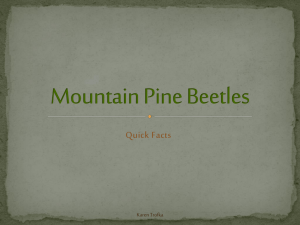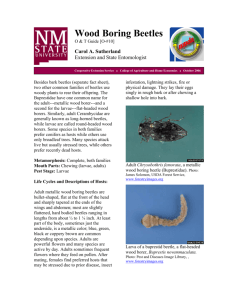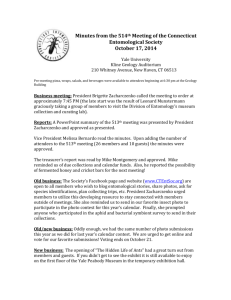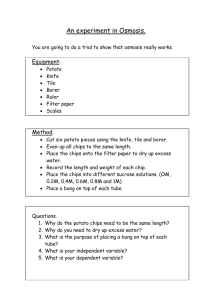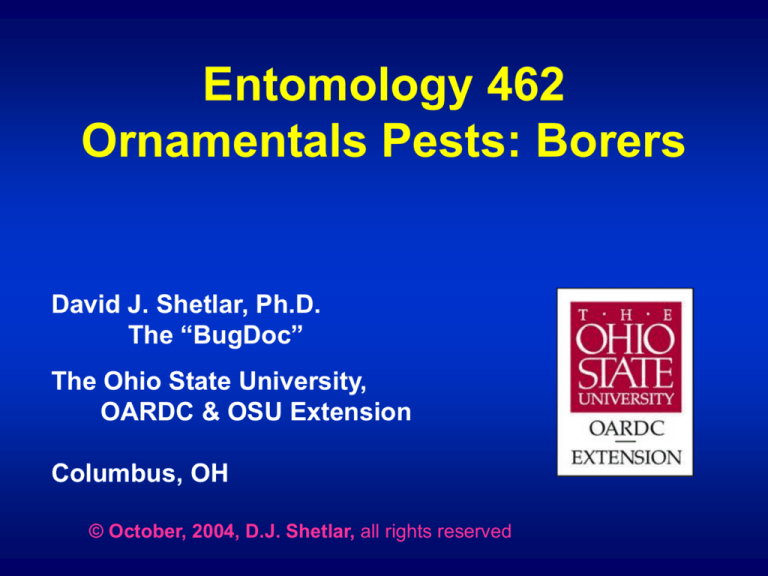
Entomology 462
Ornamentals Pests: Borers
David J. Shetlar, Ph.D.
The “BugDoc”
The Ohio State University,
OARDC & OSU Extension
Columbus, OH
© October, 2004, D.J. Shetlar, all rights reserved
Woody Ornamental Pest Groups
Borer Symptoms
“SUDDEN” Plant Death
Sawdust from Hole
Sap/Pitch from Hole
“Gouty Growth” on Trunk
or Branch
Sudden death to spruce terminal
caused by white pine weevil
larvae.
Bronze birch borer larvae
usually cause host trees to
die from the top down.
Sawdust like frass produced by
rhododendron borer. Dry sawdust
being produced by a borer
suggests that it is feeding in a
dead area.
Pitch mass caused by
zimmerman pine moth
larva. Sap or pitch
flow suggests that the
borer is feeding in
living tissues.
Woody Ornamental Pest Groups
Chewing Pests - Borers
Beetles that are Borers Roundheaded Borers (longhorn beetles)
Flatheaded Borers (metallic wood borers)
Bark Beetles (bark, shothole, ambrosia beetles)
Weevils (shoot & root weevils)
Moths that are Borers Clearwing Moths
Carpenterworms (leopard moths)
Twig, Tip & Shoot Moths
Roundheaded Borers (Cerambycidae)
(adults are known as longhorn beetles)
Elm borer adult, note antennae that are,
at least, as long as body.
Elm borer larva
is oval in profile
and produces an
oval hole.
Elm borer pupa.
Most roundheaded borers attack trees or shrubs that are dying or
have recently died. In many cases, the plant may not overtly exhibit
signs of death, at least to inexperienced plant care managers.
The few roundheaded borers that attack stressed trees usually feed in
the heartwood rather than the cambium area. This may weaken the
structure of the tree, but does not kill it outright since girdling does
not occur in the sapwood area.
Unfortunately, the larvae of cerambycid larvae are commonly found
under the bark of dead trees and are accused as being the cause of
the plant death.
Roundheaded borers usually make round or rounded-oval emergence
holes.
One roundheaded borer, the twig girdler has adults that cut a groove
in small branches which cause these to eventually break and drop.
Their larvae feed within the girdled branch. The oak pruner has larvae
that girdle small oak branches that cause these to also break out of
the trees. The larvae also feed in the dead branch. Both pests rarely
warrant control.
Locust borer adult on
goldenrod, its favorite fall
feeding ground.
Locust borer emergence
hole. Most longhorn
beetles produce round or
rounded-oval holes.
Pine sawyer adult and
emergence hole. Pine sawyers
normally don’t kill pine trees,
but adults transmit pine wilt
nematodes that do!
Pine sawyer larvae, lower left.
Spotted pine sawyer adult.
Oak Twig Pruner
Adult
Larva in twig.
Sawdust-like
frass being
pushed out of
pruned branch by
larva.
Flatheaded Borers (Buprestidae)
(adults are known as metallic wood boring beetles)
Flatheaded
appletree borer
larva.
Flatheaded
appletree borer
adult emerging.
Adult flatheaded
appletree borer.
Flatheaded borers are called this because the first thoracic segments
BEHIND the head are often expanded laterally and flattened. These larvae
usually feed in the cambium or sapwood of host plants and they produce
very flat and straight-sided burrows. By feeding in the sapwood, these
borers commonly girdle their hosts, causing sudden death.
The adults are called metallic wood borers because they are often
coppery or bronze in color. Some are bright iridescent green or blue and
are highly prized by beetle collectors. When the adults emerge, they
usually produce flattened oval or D-shaped holes.
The genus Agrilis has many species which are commonly encountered in
landscape trees. The larvae of this genus are very thin and narrow with
the thorax only slightly expanded laterally. Most adults in this genus
leave characteristic D-shaped exit holes.
Bronze birch borer larva in sapwood.
Honeylocust borer adult.
Bronze birch borer adult emerging.
Honeylocust borer emergence hole.
Note characteristic D-shape.
Bronze birch borer females tend to
lay their eggs in bark fissures or
under flaps of bark. Therefore, if a
preventive insecticide is used,
thorough coverage is essential for
success.
Bark Beetles (Scolytidae)
(also called engraver or ambrosia beetles)
Cedar bark beetle adult.
Cedar bark beetle larvae.
Pine Ips beetle and
emergence hole. These
beetles are sometimes
called shothole beetles.
Bark beetles usually attack stressed or dying trees. As with longhorn
borers, these beetles are often blamed for the death of their host tree.
The European elm bark beetle transmits Dutch Elm Disease which is a
fungus that the adult beetles pick up when they exit infected trees.
These beetles feed on the branches of healthy elms and accidentally
introduce the fungal spores. The fungus rapidly attacks the new trees,
causing branch or whole tree dieback in a year or less. These dead or
dying trees serve as new hosts for the beetles, thereby perpetuating the
cycle of the beetles and fungus.
Some conifer bark beetles, especially the southern and western pine
bark beetles, perform “mass attacks” where an adult may find a weak or
apparently healthy tree. Once located, this “scout” releases an
aggregation pheromone that attracts hundreds of additional beetles.
All the beetles bore into the tree at once, overwhelming it.
In landscapes, recently transplanted larger trees and trees suffering
from root damage due to construction or disease are especially prone
to bark beetle attack.
Weevil Borers (Curculionidae)
White
pine
weevil
adult
female
laying
eggs.
Leader killed by white pine weevils.
White pine
weevil
larvae
burrowing
down
leader.
Clearwing Borers (Sesiidae)
This group is commonly listed as the Aegeriidae
Lesser
peachtree
borer adult.
Ash/lilac borer
larva in lilac
branch.
Maple callus
borer adult.
Peachtree borer
larva in sand plum.
The clearwing moth borers are some of the most common key pests
found in urban landscapes. While they usually can not attack healthy
plants, once they get established, they may reinfest the same plant
year-after-year until it is girdled and killed.
Some of the most important species are the dogwood borer, the
rhododendron borer, the peachtree borer (in flowering peach, plum
and cherry), the ash/lilac borer, the banded ash clearwing, and the oak
borer.
Most of the clearwing borer adults can be monitored by using
pheromone traps. Traps are placed out two weeks before the species
normally flies. When the first moth is captured (males fly first), there
is usually 10 to 14 days before females are developed sufficiently to
lay eggs. This allows for susceptible plants to be treated with
preventive insecticides. Traps should be monitored three to four
weeks after the first preventive application in order to determine if
adults are still active. If so, a second treatment may be needed.
Carpenterworms
(several species)
Diagram of lesser carpenterworm adult (top), larva
(bottom), and pupa (right).
Carpenterworms are thick bodied moths that attack a variety of trees,
especially willow, elm, ash, oak, cottonwood and maples. The larvae feed
primarily in the sapwood and make scattered holes through the bark
through which they expel sawdust-like frass. The larvae feed slowly and
may take three to four years to mature. The larvae are first pinkish but
become cream colored with rows of small black spots when mature.
Attacks rarely kill their hosts, but their burrowing causes considerable
disfiguring of the bark and can structurally weaken the trunk.
A related pest, the leopard moth, has adults with white wings covered
with black spots. This European import attacks most deciduous
ornamental trees. Like the carpenterworms, attacks rarely result in
sudden plant death, but affected trees may have easily broken branches.
Trees tend to decline over many years of repeated attack.
There are few controls registered for carpenterworm or leopard moth
borers. Most recommend keeping susceptible trees in good health,
especially avoiding bark damage or poor pruning.
Maple Shoot Borers
(several species of caterpillars)
First symptom is usually sudden
tip wilting and dieback. Upon
looking closer, there us usually
some frass being pushed out of a
terminal hole.
Maple shoot
borer caterpillar.
There are several moths that burrow into the stems and shoots of deciduous
trees and shrubs. The boxelder twig borer attacks boxelder and red maple.
Larvae overwinter in dormant buds and burrow into shoots in the spring.
This causes shoot death, swollen shoots and bushy growth. Several other
species burrow into the shoots of silver maple and horsechestnuts.
Most of these pests seem to prefer small trees. Attacks decrease when the
trees mature. Early attacks can cause major problems in nurseries, because
the plants do not develop straight trunks. Infestations in established
landscape trees can usually be treated with judicious pruning.
Pine Tip or Shoot Moths
(several species, depending on location)
EPSM pupa in
damaged bud.
EPSM adult.
Pitch pine bud killed by
European pine shoot moth
(EPSM). Note small pitch mass
at base of dead bud.
There are numerous species of moths in the genus Rhyacionia that are
called pine tip or shoot moths. The European pine shoot moth and
Nantucket pine tip moth are the two most common species attacking most
ornamental and forest pines (except for white pine) in the northeastern
states. The Monterey pine, Ponderosa pine and Southwestern pine tip
moths attack pines in the Rocky Mountains and Pacific Coast States.
Heavily attacked young trees, especially in tree plantations and nurseries,
can be severely stunted and tend to have crooked trunks, making the trees
unsuitable for ornamental use or lumber production.
Most species attack buds as early stage larvae and some burrow down
expanding shoots in early summer. This kills the buds and shoots,
causing loss of leader dominance. Side shoots may eventually gain
dominance, but the trunk will have a conspicuous crook.
Insecticides are usually applied to kill larvae as they hatch from eggs and
try to burrow into buds. Systemic insecticides are occasionally used to kill
larvae once they have entered buds or shoots.
Borer Control
Cultural –
Use plants that are not prone to borer attack!
Plant health care – plants in good growing conditions can
usually repel borer attacks.
Avoid Plant Damage – damaged plants are prone to attack.
Biological –
Determine if present (parasites & predators)
Usually not effective because they attack after infestation.
Chemical –
PreventiveAdulticides: contact or stomach pesticides applied when
adult is active. Select long residual materials.
CurativeLarvacides: use systemic pesticides, being aware of
translaminar and translocated activities. Translaminar
activity is not usually effective against borers.
Woody Ornamental Pest Groups
Chewing Pests –
Cambium Miners
Moths Flies Beetles (all uncommon and
not usually damaging)
Maple Cambium Miner
This is a small dipterous pest. Some call these pests “bark miners”
because they actually feed in the cortex and phloem immediately under the
epidermis.

